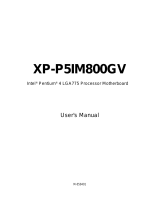
- 4 -
Table of Contents
Box Contents ................................................................................................................. 6
Optional Items................................................................................................................. 6
GA-EG41M-S2H/S2 Motherboard Layout ...................................................................... 7
Block Diagram................................................................................................................ 8
Chapter 1 Hardware Installation .................................................................................... 9
1-1 Installation Precautions ..................................................................................... 9
1-2 Product Specifications .................................................................................... 10
1-3 Installing the CPU and CPU Cooler.............................................................. 13
1-3-1 Installing the CPU ................................................................................................ 13
1-3-2 Installing the CPU Cooler ................................................................................... 15
1-4 Installing the Memory ..................................................................................... 16
1-4-1 Dual Channel Memory Configuration................................................................ 16
1-4-2 Installing a Memory............................................................................................. 17
1-5 Installing an Expansion Card ......................................................................... 18
1-6 Back Panel Connectors ................................................................................. 21
1-7 Internal Connectors ........................................................................................ 23
Chapter 2 BIOS Setup................................................................................................. 35
2-1 Startup Screen ................................................................................................ 36
2-2 The Main Menu .............................................................................................. 37
2-3 MB Intelligent Tweaker(M.I.T.) ....................................................................... 39
2-4 Standard CMOS Features ............................................................................. 46
2-5 Advanced BIOS Features.............................................................................. 48
2-6 Advanced Chipset Features ........................................................................... 50
2-7 Integrated Peripherals ..................................................................................... 52
2-8 Power Management Setup ............................................................................. 55
2-9 PnP/PCI Configurations................................................................................. 57
2-10 PC Health Status ........................................................................................... 58
2-11 Load Fail-Safe Defaults................................................................................... 59
2-12 Load Optimized Defaults................................................................................. 59
2-13 Set Supervisor/User Password..................................................................... 60
2-14 Save & Exit Setup......................................................................................... 61
2-15 Exit Without Saving ....................................................................................... 61




















